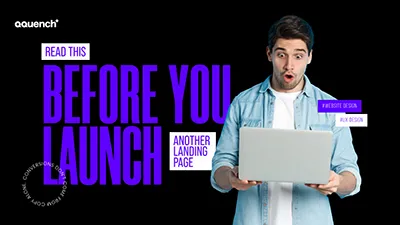
Your Website Isn’t Mobile-Ready Until It’s Thumb-Ready
In 2025, over 80% of your users meet your brand on a mobile ux screen first.
And still, we see designs built for desktops — squashed into phones.
Buttons in no-man’s land. Fonts that need a microscope. Menus that punish fat fingers.
At Qquench, we design for thumbs, not just screens. And today, we’re calling out the biggest mobile UX sins killing your conversions.
Sin #1: Tap Targets That Hate Fingers
Ever tried to hit a link that’s:
- Too small
- Too close to another
- In the upper-left corner?
Your users have too. And they bounced.
Fix: Follow the Thumb Zone Rule
Design CTAs, menus, and key actions in the area your thumb naturally reaches.

Sin #2: Desktop Menus Pretending to Be Mobile Menus

That elegant multi-level nav bar? Total chaos on mobile.
- Dropdowns that don’t open
- Menus that cover the screen
- Hidden subpages no one finds
Fix: Use progressive disclosure — reveal content gradually with simple icons and labels that adapt based on behavior.
Sin #3: Giant Hero Images That Push Content Below the Fold
Your brand story matters. But not at the cost of scroll fatigue.
Fix: Compress intros. Use dynamic hierarchy: Headline → benefit → CTA.
Get to value in the first 3 seconds.
Sin #4: Forms That Demand Too Much Thumb Acrobatics
Typing on mobile is a chore. Your form should feel like a conversation.
Fix:
- Use autofill, dropdowns, tap-to-select
- Minimize input fields
- Add progress bars (even if it’s just 2 steps)
Pro tip: End with “Done” or “Let’s Go” — not “Submit.”
Sin #5: Ignoring Mobile-First Gestures
Taps are just one part of the mobile playbook.
Users also:
- Swipe
- Long-press
- Scroll-flick
- Pinch-to-zoom
Fix: Make interactions gesture-aware, not just click-aware. Add animations or microfeedback to guide the motion.
Case Snapshot: App Redesign That Saved the Sale
An e-commerce client was bleeding users at checkout — on mobile only.
We:
- Repositioned CTAs for thumb reach
- Collapsed unnecessary fields
- Turned address entry into a map-based picker
Result:
- 26% decrease in cart abandonment
- 2x more users completed purchase under 60 seconds

The Qquench Rule: Design for Reality, Not Wireframes
People scroll while multitasking.
With one hand.
In bad light.
While holding coffee.
Your UX has to respect that chaos. That’s where conversions live.
Your Mobile UX Should Be Finger-Friendly, Fast, and Forgiving
If your site isn’t built for the way humans actually use phones, it’s not mobile-ready.
Let’s Fix the Friction That Costs You Clicks
Qquench audits and redesigns mobile UX with one goal:
Make it so natural, users never think about the interface — just the action.
Qquench: Thumb-tested, conversion-approved.




